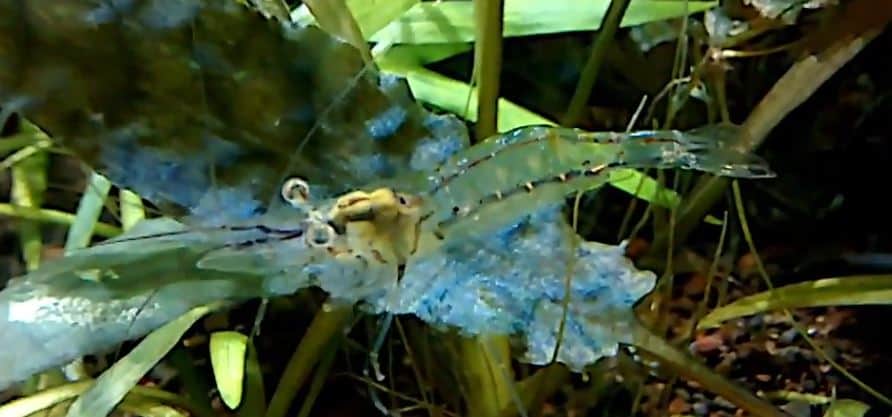Ghost shrimp are a popular addition to aquariums due to their clear, transparent bodies and ghost-like appearance. Unfortunately, ghost shrimp can contract Ichthyophthirius multifiliis, a parasitic ciliate, and can spread the disease to other fish.
It is important to understand the signs and symptoms of ich and the treatments and preventative measures that can be taken to keep the shrimp and other fish safe.
This article will discuss the signs and symptoms, treatments and preventative measures, and other risks associated with caring for ghost shrimp and preventing ich.
Key Takeaways
- Ghost shrimp can get ich, but they typically only experience mild symptoms.
- Ich can spread from ghost shrimp to other fish in the aquarium.
- Ich does not significantly impact the health of ghost shrimp, but it can negatively affect other fish.
- Treating ich in a shrimp tank can be done with products like Ich Attack and Nox Itch, as well as salt and warm temperatures.

Signs and Symptoms
White spots on ghost shrimp, sudden behavior changes, rubbing against objects, and decreased interest in food are indications of ich in ghost shrimp.
Behavioral changes, such as becoming lethargic or shy, can be signs of ich in ghost shrimp. Additionally, the parasite can cause shrimp to rub against objects in the tank.
Ghost shrimp affected by ich may also lose interest in food or become sluggish. The impact of ich on the feeding habits of ghost shrimp can be seen, as the parasite can decrease the shrimp’s appetite or cause slower activity levels.
Knowing these signs and symptoms of ich in ghost shrimp is important to diagnose and treat the parasite quickly.
Treatment and Prevention
Treatment and prevention of Ichthyophthirius multifiliis in aquarium environments require isolating new specimens and implementing effective products. To properly manage ich in aquariums, the following steps should be taken:
- Isolation:
- Utilize quarantine tanks to isolate new specimens.
- Monitor for signs of ich and treat accordingly.
- Take necessary steps to prevent the spread of ich.
- Products:
- Utilize Ich Attack and Nox Itch for effective treatment.
- Consider salt treatments, but be aware of shrimp and plant compatibility.
- Water Quality:
- Maintain proper water quality to prevent ich from occurring.
- Be aware of overcrowding and other factors that may cause ich.
It is of utmost importance to take necessary steps to prevent the spread of ich and ensure the health and well-being of tank inhabitants. Research and consultation with experts can be invaluable in treating and preventing ich in aquarium environments.
Other Risks
In addition to Ichthyophthirius multifiliis, other diseases, and parasites can occur in shrimp tanks. Bacterial infections such as bacterial shell disease, parasites like flukes and worms, and fungal infections like cotton wool can all affect ghost shrimp. Proper tank maintenance and water quality should be maintained to prevent these diseases. Ghost shrimp behavior can also indicate the presence of one of these diseases. For example, decreased interest in food, sudden behavior changes, or rubbing against objects can all be signs of infection. A two-column, four-row table can help illustrate these signs:
| Disease | Signs in Ghost Shrimp |
|---|---|
| Bacterial | Decreased Appetite |
| Fungal | Sudden Behavior |
| Parasitic | Rubbing Objects |
| Ich | White Spots |
To ensure the well-being of ghost shrimp, research should be done on the species’ susceptibility to disease, and consultation with experts or experienced aquarists should be sought for advice. A quarantine tank is also recommended to isolate new shrimp for the parasite-free introduction. Aquarists can protect their ghost shrimp from various diseases and parasites by staying informed and taking proactive action.
Frequently Asked Questions
Conclusion
In conclusion, knowing about the potential health risks associated with Ghost shrimp, including Ichthyophthirius multifiliis is important. Proper examination, quarantine, water quality upkeep, and avoiding overcrowding are all important for preventing these risks.
Additionally, treatments such as Ich Attack and Nox Itch and salt and warm temperatures may be necessary for treating ich.
Lastly, other diseases and parasites, such as bacterial infections, parasites, and fungal infections, should also be considered when caring for Ghost shrimp. Research and consultation with experts can help ensure the health and safety of these crustaceans.
